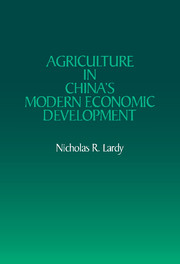Book contents
- Frontmatter
- Contents
- List of tables, figures, and maps
- Preface
- Map 1 The provinces of the People's Republic of China
- 1 The role of agriculture
- 2 Planning and allocative efficiency
- 3 Prices and intersectoral resource transfers
- 4 Living standards and the distribution of income
- 5 Prospects for reform
- Appendixes
- Notes
- References
- Index
1 - The role of agriculture
Published online by Cambridge University Press: 16 September 2009
- Frontmatter
- Contents
- List of tables, figures, and maps
- Preface
- Map 1 The provinces of the People's Republic of China
- 1 The role of agriculture
- 2 Planning and allocative efficiency
- 3 Prices and intersectoral resource transfers
- 4 Living standards and the distribution of income
- 5 Prospects for reform
- Appendixes
- Notes
- References
- Index
Summary
Economic development in China accelerated rapidly after 1949. Excluding rapid postwar recovery, real per capita output tripled in the three decades between 1952 and 1981 (Table 1.1). This is in marked contrast to the first half of the twentieth century, when there was no sustained per capita growth (Perkins 1975b).
Accelerated growth has been accompanied by far-reaching changes in the structure of output. The share of national income originating in industry rose from 18 percent in 1952 to almost 50 percent in 1979, while agriculture's share shrank from 60 to less than 40 percent. As industry's share more than doubled, its composition also shifted markedly. Because of a dramatic increase in the rate of capital formation, the share of producer goods in industrial output grew from about a third in 1952 to well over half by the late 1970s, primarily reflecting the rapid growth of machinery and metal products (Yang Chien-pai and Li Hsüeh-tseng 1980, 20). This pace of structural transformation far exceeds that experienced by today's advanced industrial countries during comparable periods of economic development (Kuznets 1971).
Paradoxically, although the pace of growth and the structure of output have changed dramatically since 1949, the population and the composition of the labor force remain predominantly agrarian.
- Type
- Chapter
- Information
- Agriculture in China's Modern Economic Development , pp. 1 - 17Publisher: Cambridge University PressPrint publication year: 1983



